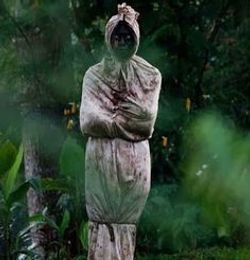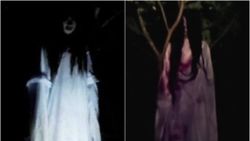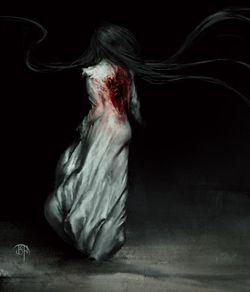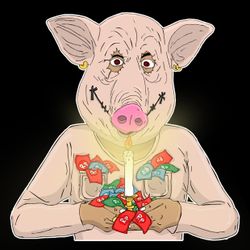Jul 8, 2024
Indonesian urband legends

The Kuyang is a prominent figure in Dayak mythology, particularly among the Dayak people of Borneo, including those in East Kalimantan. Here's an overview of the Kuyang:
The Kuyang is believed to be a witch or sorcerer who possesses the ability to detach their head from their body. In its true form, the Kuyang appears as a normal person during the day but transforms into a flying head at night.
The Kuyang is associated with dark magic and is feared for its ability to harm people, particularly children and pregnant women. It is said to feed on blood, often targeting infants or unborn babies.
According to folklore, the Kuyang practices black magic and may be involved in rituals to gain supernatural powers. It is believed to fly at night, seeking out victims whose blood it consumes to maintain its powers.
Rituals and protective measures are employed by communities to ward off the Kuyang. These can include placing thorny plants around homes, reciting prayers, or using amulets to repel evil spirits.
The legend of the Kuyang reflects cultural beliefs and fears related to sorcery and supernatural entities in Borneo. It remains a significant part of Dayak folklore, passed down through generations to caution against dark forces and to reinforce community beliefs in spiritual protection.

A Pocong is a supernatural entity in Indonesian and Malaysian folklore, particularly among the Malay and Javanese communities. Here are the key characteristics and beliefs associated with the Pocong:
A Pocong is the spirit of a deceased person whose body is wrapped in a white burial shroud (kain kafan). Traditionally, the shroud is tied with rope around the head, neck, and feet. This binding causes the Pocong to appear as a figure that hops or floats rather than walks.
According to folklore, the Pocong is a soul that has not been properly released from the physical world. It arises when the ties securing the burial shroud are not untied after burial, trapping the spirit in a state between life and death.
Pocongs are believed to haunt graveyards and may also wander into villages or homes during the night. They are considered harbingers of misfortune or death, appearing to family members or loved ones as a sign of impending danger or to seek help in releasing them from their earthly ties.
Communities employ various rituals to prevent or deal with encounters with Pocongs. These include reciting prayers, untying the knots on the burial shroud, or performing traditional cleansing ceremonies to release the trapped spirit.
The Pocong has become a popular figure in Indonesian horror movies and literature, often depicted as a spooky and eerie presence associated with graveyards and supernatural occurrences.
The legend of the Pocong underscores beliefs about the afterlife, spirits, and the importance of proper burial rituals in Indonesian and Malay cultures. It continues to fascinate and frighten people, reflecting cultural attitudes toward death and the supernatural.

The Kuntilanak, also known as Pontianak in Malay folklore, is a prominent female ghost in Indonesian and Malaysian mythology. Here are some key details about the Kuntilanak:
The Kuntilanak is often depicted as a beautiful woman with long black hair, dressed in a white gown. Her appearance is deceptive, as she can transform into a horrifying figure with sharp fangs and bloodshot eyes.
It is believed that the Kuntilanak is the vengeful spirit of a woman who died during childbirth or due to tragic circumstances. Her spirit returns to seek revenge or torment the living, especially men and children.
The Kuntilanak is known for her chilling cry, resembling that of a baby or a woman in distress. This cry is used to lure unsuspecting victims, often to secluded places where she can attack or possess them.
ccording to folklore, the Kuntilanak preys on those who disrespect or harm women. She may also target pregnant women or newborn babies, seeking to fulfill a maternal role that she was denied in life.
Various rituals and protective measures are employed to ward off the Kuntilanak, such as hanging sharp objects outside homes, reciting prayers, or using garlic and other charms believed to repel evil spirits.
The legend of the Kuntilanak persists as a cautionary tale about respecting women and the consequences of past misdeeds. It reflects cultural beliefs surrounding death, motherhood, and the supernatural in Southeast Asian folklore.

Jelangkung is a traditional Indonesian ritual that involves summoning spirits using a doll or puppet. Here's an overview of how the Jelangkung ritual is typically conducted:
The ritual begins with the preparation of a special doll or puppet known as Jelangkung. This doll is often made from wood and dressed in traditional Indonesian clothing. It may also include a container, like a coconut shell, to hold offerings.
Participants gather in a darkened room or a secluded place, often in the evening or at night. They form a circle around the Jelangkung doll and begin chanting or reciting prayers to invite spirits to inhabit the doll.
Once the ritual is underway, participants ask questions to the spirit believed to have entered the Jelangkung doll. The spirit is thought to respond by causing movements in the doll, such as nodding, shaking, or pointing, to indicate answers.
To conclude the ritual, participants thank the spirit and offer it symbolic gifts or offerings, such as rice, flowers, or incense. This is done as a sign of respect and to ensure the spirit departs peacefully.
Jelangkung is rooted in Indonesian animistic beliefs and serves as a means to communicate with the spirit world. It is often performed during cultural ceremonies or gatherings, reflecting the community's beliefs in the supernatural and the continuity of spirits beyond death.
Jelangkung remains a significant part of Indonesian folklore and spiritual practices, illustrating the country's diverse cultural heritage and beliefs about the interaction between the living and the spirit world.

"Sundel Bolong" is a prominent and chilling figure in Indonesian folklore. The name translates to "prostitute with a hole," referring to a female ghost with a large, gaping hole in her back. According to legend, Sundel Bolong is believed to be a woman who died tragically during childbirth or as a result of violence, leaving her with this distinctive feature.
She is often depicted as a beautiful woman, sometimes wearing a kebaya (traditional blouse) and a long skirt, to disguise her horrifying secret. Sundel Bolong is said to lure men with her allure, only to reveal her terrifying form when they get close. Her vengeful spirit may haunt places associated with her tragic death, seeking revenge on those who wronged her or taking revenge on men in general.
This legend is deeply ingrained in Indonesian culture, serving as a cautionary tale about the consequences of mistreating women and the dangers of promiscuity. Sundel Bolong continues to be a popular figure in Indonesian horror stories, movies, and folklore, adding to the country's rich tapestry of supernatural beliefs.

Tuyul is a supernatural being in Indonesian folklore, particularly prominent in Javanese culture. Here are some key points about Tuyul:
Tuyul is typically depicted as a small, childlike figure with a bald head and glowing red eyes. It may appear naked or wearing traditional Javanese attire.
Tuyul is considered mischievous and curious, often described as a spirit or ghost of a deceased child. It is believed to have the ability to locate and steal money or valuables on behalf of its owner.
In folklore, people who possess a Tuyul can command it to steal wealth, such as coins or jewelry, from others. The Tuyul then brings these items back to its master, who benefits from its supernatural abilities.
While Tuyul can be beneficial to its owner in acquiring wealth, it requires proper care and management. Rituals and offerings are performed to maintain control over the Tuyul and prevent it from causing harm or mischief to others.
Belief in Tuyul reflects cultural attitudes towards wealth, supernatural beings, and the afterlife in Indonesian society, particularly in Javanese communities where such folklore is deeply ingrained.
Tuyul remains a fascinating and sometimes controversial figure in Indonesian folklore, blending elements of spirituality, superstition, and cultural beliefs about the unseen world.

The "Hantu Jeruk Purut," or the Ghost of Jeruk Purut, is a well-known urban legend in Jakarta, Indonesia. Jeruk Purut is an area in South Jakarta that is famous for its old cemetery and the ghost stories associated with it. Here are some key aspects of this urban legend:
According to local lore, the Ghost of Jeruk Purut is said to be the spirit of a woman who was buried in the cemetery under tragic circumstances. She is often depicted wearing a white dress and is believed to haunt the cemetery grounds, especially at night.
Witnesses claim to have seen the ghostly figure of a woman with long hair and wearing a white dress wandering among the tombstones or walking along the cemetery paths. Some stories also describe eerie sounds or inexplicable sensations experienced by those visiting the area.
The legend of Hantu Jeruk Purut is deeply ingrained in Jakarta's cultural fabric, serving as a cautionary tale about respecting the dead and the consequences of disturbing graves or disrespecting burial grounds.
The ghost stories surrounding Jeruk Purut Cemetery have been popularized through local media, folklore, and word-of-mouth, attracting both believers and skeptics who are intrigued by the supernatural aspects of Jakarta's urban landscape.
Overall, the Ghost of Jeruk Purut is one of Jakarta's most enduring urban legends, reflecting the city's rich history, cultural beliefs, and fascination with the paranormal.

"Jenglot" is a mysterious creature or object found in Indonesian and Malaysian folklore. It is typically described as a tiny, doll-like figure, often made of animal or human hair mixed with resin, and possessing supernatural powers. The origin and existence of Jenglot are debated, with some believing them to be ancient mystical artifacts or even preserved creatures with magical abilities.
In folklore, Jenglot are said to bring good fortune or protection to their owners, but they can also be dangerous if not properly cared for or respected. Owners of Jenglot are believed to feed them with drops of blood, milk, or other offerings to maintain their power. They are often kept in small boxes or containers, away from sunlight and prying eyes.
Encounters with Jenglot are rare and controversial, with some dismissing them as elaborate hoaxes while others maintain their belief in their supernatural nature. Despite skepticism, stories and sightings of Jenglot persist, contributing to the mystique and fascination surrounding Indonesian and Malaysian folklore.

"Babi Ngepet" is a mythical creature from Indonesian folklore, particularly prevalent in Javanese mythology. The term translates to "pig thief" in English. Here are some key aspects of the legend:
Babi Ngepet is believed to be a supernatural being that takes the form of a pig or a wild boar. It possesses magical powers and is said to be able to steal valuables, money, or crops from people's homes or fields.
According to the legend, Babi Ngepet is often summoned or controlled by individuals practicing black magic or occult rituals. These practitioners allegedly send the creature to steal from others, using its abilities to enrich themselves at the expense of their victims.
The legend of Babi Ngepet reflects broader cultural beliefs in Indonesia regarding magic, spirits, and the consequences of unethical practices. It serves as a cautionary tale about the dangers of dabbling in dark arts and the potential repercussions for those who engage in such activities.
Different regions of Indonesia may have variations of the Babi Ngepet legend, with slight differences in the creature's appearance, abilities, or the methods used to summon or control it.
Despite its mythical nature, stories of Babi Ngepet continue to circulate in Indonesian folklore, occasionally appearing in media and popular culture as a character or plot element in movies, television shows, or literature.
Overall, Babi Ngepet remains a fascinating and somewhat fearsome figure in Indonesian mythology, blending supernatural elements with cultural beliefs and warnings against greed and dark magic.

Genderuwo (sometimes spelled Genderwo) is a mythical creature in Javanese mythology, particularly among the Javanese people of Indonesia. Here are the key aspects of Genderuwo:
Genderuwo is often described as a hairy, ape-like creature with a muscular build. It is humanoid in form but larger and more robust than a human. Its appearance can be intimidating, with red or fiery eyes.
Genderuwo is believed to inhabit forests, remote areas, or abandoned places. It is considered a guardian of nature or a protector of certain locations. In some stories, Genderuwo may also act as a spiritual guide or a warning sign, appearing to people to convey messages or foretell events.
According to folklore, encounters with Genderuwo can be both unsettling and enlightening. People who encounter Genderuwo may experience a sense of awe or fear, depending on the creature's intentions and the circumstances of the encounter.
Genderuwo is often associated with mystical powers and abilities, such as shape-shifting or invisibility. It is believed to have a strong connection to the spiritual realm and may be summoned or communicated with through certain rituals or practices.
Genderuwo stories reflect Javanese beliefs in supernatural beings and the mystical forces that influence human lives. They are part of the rich oral tradition passed down through generations, serving to explain natural phenomena, protect sacred places, or caution against disrespecting spiritual boundaries.
Genderuwo remains a fascinating figure in Indonesian folklore, representing the intersection of mythology, spirituality, and cultural heritage among the Javanese people.
By undefined
20 notes ・ 118 views
English
Intermediate